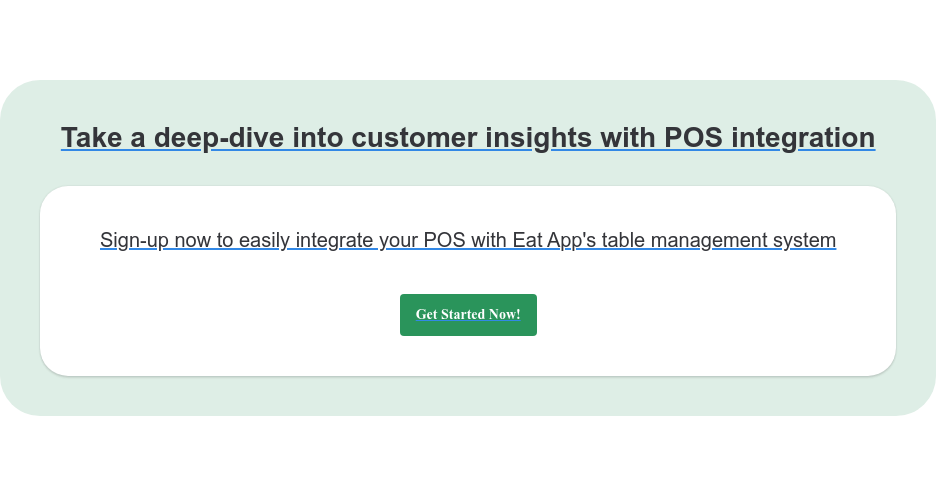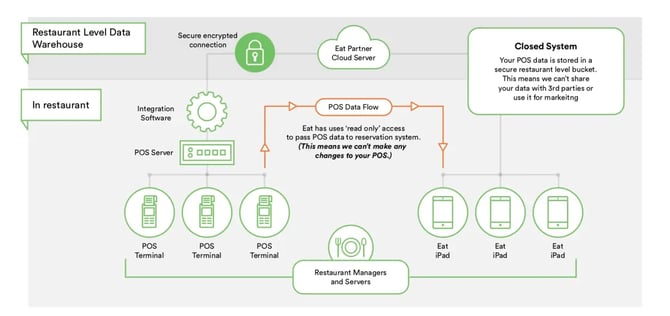We're happy to announce Eat App's Integration with your restaurant's point of sale (POS) system.
To help restaurants boost efficiency, Eat App's POS Integration connects tickets and orders to customers in the background. Throughout the entire customer experience, from the first visit to the return visitor, we enrich your guest data.
Want to know more about POS integration and how it can benefit your restaurant? In this article, we will take an in-depth look at why restaurants need to integrate their POS systems, the benefits & more.
What is POS integration?
The restaurant business has recently embraced technology after previously being skeptical of it. The management of reservations, employees, inventory, loyalty programs, take-out, and delivery are just a few of the front and back-of-house operations that restaurants handle today with the help of software.
Now, they can accomplish more with fewer resources, but it has also led to scenarios in which four or five different technological solutions are running independently. However, you can connect the dots and gain a much bigger picture when two applications share data among themselves.
In John's case, the restaurant is able to determine how much John has spent in the past because of the connection of POS data with the reservation management system.
These two tools really do work well together.
Why do restaurants need POS Integration?
Traditionally, the POS system has always been used to process payments, monitor restaurant revenue performance, find popular menu items for menu engineering, and for accounting purposes. But because POS systems use tickets to store data, they won’t know who the guests behind them are as guest data is commonly stored in a reservation or CRM system.
As a restaurant operator, the idea of sharing POS data with a reservation management system may not be something usually on your mind.
But it should be. Because when the two systems are integrated, you can connect the dots between guests and revenue, and gain much deeper insight into your customers.
How does POS integration work?
Your POS is the central data collection hub. When it is integrated with other systems, data flows from the POS terminals to a centralized POS server and then, through custom integration software, to a cloud-based data warehouse, to the system where the data is being shared. For example, the guest lifetime spend is pulled directly from your POS and registered into your reservation system without requiring any manual intervention.
The example below assumes the POS is sharing data with a restaurant reservation system. POS data flows only one way to the connected devices and all data is encrypted along the way making it a totally closed and secure system.

Learn how Eat App’s Table Management System saves time by auto-matching POS tickets with your tables in real time.
What are the benefits of POS integration?
Connecting the POS and reservations management systems transforms running a restaurant in two key ways:
1. Tailor the guest experience
When integrated with a table management system, your POS software opens up a plethora of new data that was previously unavailable. Data points like guests’ lifetime spend and average spend per reservation provide restaurants with a deep insight into their guests that were not accessible before. This allows them to custom-tailor every guest’s dining experience from beginning to end.
John’s example illustrates this quite well. Through POS integration, managers can see what a guest usually spends money on and comp them previously ordered items, or simply ask the right questions. In short, instead of approaching each guest with generic statements, your staff can now personalize their approach based on the guest’s past behavior.
The personalization is not limited to just the dining experience, it also allows restaurants to send out targeted messaging to their customers based on factors like their spending habits or what they usually order. For instance, if John orders sushi on every visit, the restaurant can target him by messaging about their next sushi night and increase the probability of him returning as the message is tailored to his preferences.
By enabling a personalized approach to guest experiences, POS integration helps restaurants build a stronger relationship with its customers
The goal of these activities is customer retention, which is particularly important with high spenders. It’s not just that VIPs like John bring a lot of cash through the door. They can be the best ambassadors for your restaurant and fuel word-of-mouth.
A great way to identify them is through realized revenue rather than number of visits or guesswork. If you know that 10% of your guests spend a certain amount in a quarter or a year you can easily decide who is a VIP and who is not.
POS integration doesn't have to be the only way you track VIPs, but it adds another way of understanding your guests and which ones are likely to become strong supporters of your restaurant.
By having this information in your reservation system, you can also easily and automatically tag, segment, and target your VIP guests with tailored messaging.
2. Revenue reporting
Along with guest data, POS integration also provides an in-depth insight into the financial side of things - total sales, revenue trends, and many more data points that provide a more comprehensive understanding of your restaurant’s financial performance.
It provides a centralized place for all data collection and minimizes human errors as the entire system is digitally integrated. This not only saves your staff from hours worth of work, but also makes your revenue reporting easier and more accurate.
Having all the revenue and sales data in one place also makes it easier and more efficient for staff to report performance to their superiors, which enables consistent and correct reporting.
This way, the managers have a real-time representation of the financial situation and can immediately identify and address any issues that may affect overall restaurant operations with data-backed decisions.
3 must-gave features of a POS integration solution
When you decide to invest in an integration solution, there are three important things to look for.
Flexibility. The solution you choose should be able to work not only with your POS systems, but also with most other providers, in case you switch to a different one in the future.
Data security. When you connect your POS system and customer database, you’re creating a new set of data which is twice as sensitive, as it includes sales and customers’ personal information. The integration provider should therefore have a solid cloud-based infrastructure.
Privacy protection. Finally, the integration solution will need to take data protection very seriously, without even contemplating the option of selling or sharing customers’ data with other parties.
4 Useful data reports you can get from POS integration
Here are a few useful reports that you can access by integrating your POS system with a table management system like Eat App:
- Guest Total Spend: This data point allows you to identify your high-spenders by showing the total amount of money spent by them at your restaurant. Knowing who they are can help your staff provide them with a high-quality guest experience to keep them coming back for more.
- Average Spend Per Cover: Another data point that can help identify your VIP customers by showing you their average spend per cover based on each visit. Both these data points together provide a complete picture of a guest’s spending habits.
- Menu Items: POS integration also helps you know exactly what your guests ordered on each visit to better understand their preferences. This also enables a much more refined level of segmentation and allows restaurants to target guests with hyper-specific messaging.
- Designated Servers: POS data also reflects which server was in charge of each guest/table. In case of any errors or issues, you can easily pinpoint and communicate with the right employee to get clarity about the situation.
Eat App allows you to take it one step further by allowing you to filter your entire guest book based on these metrics to use for marketing and loyalty campaigns. You can view data, segment and message your guests all through one dashboard without having to move back and forth between different systems.














.webp?width=200&name=v2-15mknc-qpw1b%20(1).webp)
.webp?width=200&name=v2-15kqni-p0exl%20(1).webp)
-1.png?width=1812&height=1072&name=TripAdvisor%20%26%20More%20Bookings%20(1)-1.png)
-2.png?width=1812&height=1072&name=Google%20Bookings%20(1)-2.png)


-1.png?width=200&name=TripAdvisor%20%26%20More%20Bookings%20(1)-1.png)
-2.png?width=200&name=Google%20Bookings%20(1)-2.png)
-1.png?width=200&name=Instagram%20Bookings%20(1)-1.png)
-1-png.webp?width=200&name=Facebook%20Integration%20Rectangle%20(1)-1-png.webp)







.webp?width=200&name=download%20(1).webp)
%20(1)-2.webp?width=200&name=Eat%20(34)%20(1)-2.webp)
%20(1)-2.webp?width=200&name=Eat%20(18)%20(1)-2.webp)











.webp?width=144&height=72&name=Eat%20App%20Logo%20(3).webp)